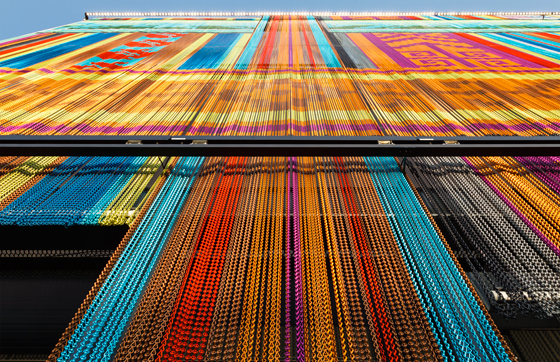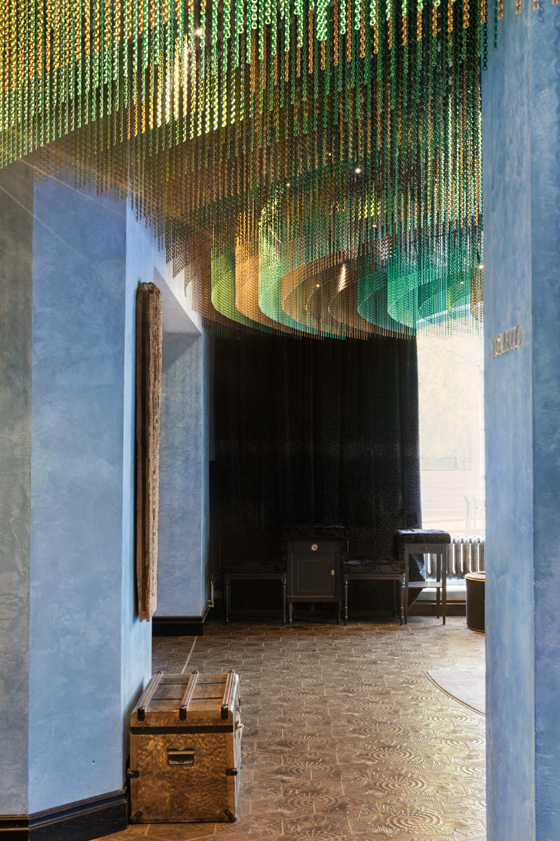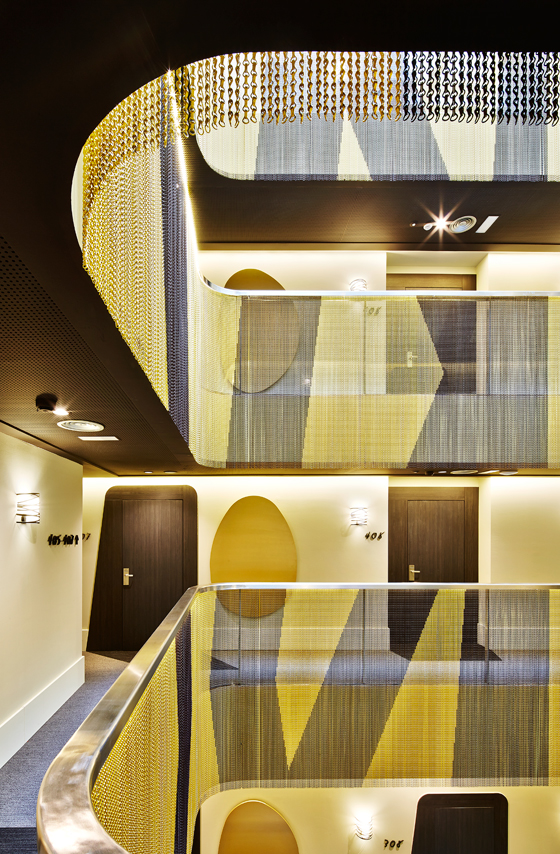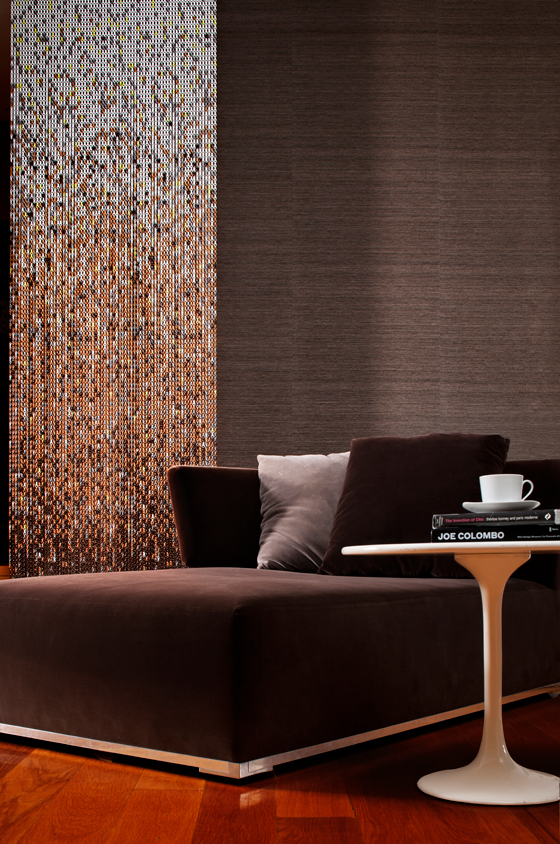It’s curtains for Expo 2015
Historia de la marca de Giovanna Dunmall
Montblanc, España
30.06.15
The go-to Spanish manufacturer of high-end, space-shaping mesh curtains has turned the Ecuadorean Pavilion at Milan’s Expo 2015 into a must-visit destination.
The rectangular Ecuador Pavilion designed by Bilbao firm Zorrozua y Asociados looks like it is wrapped in woven fabric from a distance. It is actually made out of metallic curtains produced by Spanish company KriskaDECOR

The rectangular Ecuador Pavilion designed by Bilbao firm Zorrozua y Asociados looks like it is wrapped in woven fabric from a distance. It is actually made out of metallic curtains produced by Spanish company KriskaDECOR
×Amid the architectural noise and nationalistic pomp of a World Expo, it can be tough to stand out and convey a nation’s cultural character without falling into the trap of posturing clichés or pompous self-aggrandisement.
One pavilion at this year’s Milan Expo has pulled off ‘striking and eye-catching’ as well as rich, warm and layered. The Ecuador Pavilion stands out on the site’s main drag thanks to four facades wrapped in a captivating, multi-chromatic mesh featuring geometric patterns, folkloric symbols and enigmatic motifs inspired by the traditional textiles of the indigenous Otavalo people of northern Ecuador. From a distance, the three-storey rectangular volume appears to be clad in a highly textured fabric; a closer look at the shimmering canvas reveals that it is made out of metal chains that sway gently in the wind.
From close up you can see the curtains are made of long chains that in turn are composed of individual anodised aluminium chain links. They come in brilliant or matt colours

From close up you can see the curtains are made of long chains that in turn are composed of individual anodised aluminium chain links. They come in brilliant or matt colours
בIt’s the biggest outdoor project we have ever done and the first time we have covered an entire structure,’ says Mònica Leranoz, Sales Director at KriskaDECOR, a manufacturer located in northern Spain that has made curtains and separators out of deceptively simple-looking metal chain-links since 1926. ‘For us it’s a hugely important project not only because of its size but also because the Expo is such an international event.’ It’s also the first time Ecuador has taken part in the Expo with a national pavilion.
The dimensions of the Ecuador Pavilion are indeed impressive; the surface area to be covered measures a whopping 765 square metres and the largest facades are 25.4 metres in width and 10.5 metres in height. The designers, Bilbao-based Zorrozua y Asociados, turned to KriskaDECOR to bring their idea to life because it was a material that could communicate the bright colours and emotions of typical Ecuadorian and indigenous woven fabrics while simulating the motion of textiles hanging in the wind. Paradoxically, metal offered more versatility than a two-dimensional piece of textile ever could – a pavilion that rippled, swayed and sparkled in the sunlight. And that lit up like a beacon of colour at night when illuminated.
At night the Ecuador Pavilion is illuminated and its patterned metallic curtain canvas becomes a beacon of colour and warmth on the 1.1 square-kilometre Expo site in Milan

At night the Ecuador Pavilion is illuminated and its patterned metallic curtain canvas becomes a beacon of colour and warmth on the 1.1 square-kilometre Expo site in Milan
×Over the past few years, KriskaDECOR has become the go-to manufacturer for large-scale installations and projects by some of the biggest designers, design practices and hospitality groups in the world, including Patricia Urquiola, Philippe Starck, HBA and Gensler. Appealingly, it is still a family-run affair (and now in its third-generation) and also still creates products for the domestic and residential markets (its mainstay when it first started) that can be used as space dividers or decorations on ceilings and walls.
The materials and technology have been updated, refined and reinvented time and again. ‘The company used to make the chains out of iron, which was much heavier, but soon discovered aluminium,’ says Leranoz, who reveals that a square metre of chain curtains is deceptively lightweight and weighs in at 3 kilograms. Initially the company sold the product for use as door screens in small corner shops, cafes and homes during the summer months. In the days before air-conditioning, these holey curtains were commonplace throughout Spain and the Mediterranean, allowing ventilation in; their jingle-jangle in the breeze a moment of comfort in the blazing midday heat.
This installation in the lobby of the new Stora Hotellet in Umea, Sweden is made of dozens of layers of chains in matt and shiny browns and greens and hung in circles to look like a coral reef on the seabed

This installation in the lobby of the new Stora Hotellet in Umea, Sweden is made of dozens of layers of chains in matt and shiny browns and greens and hung in circles to look like a coral reef on the seabed
×A big step forward occurred in the 1950s, ‘when the father of the current owner developed an anodisation process that makes the chains resistant to wind, sun and rain’ explains Leranoz. Later advances were made to apply colour to the chain-links and about 15 years ago the company started to reproduce images and patterns on the curtains at clients’ requests.
The company prides itself on being able to turn almost any design into reality by using different-shaped rails (wavy, curved or straight) and gathering and layering the chains to create three-dimensional volumes. ‘This is a material we can adapt to almost any idea,’ says Leranoz. A recent project that has garnered design critics’ plaudits and showcases the material’s diaphanous qualities is the maritime-themed Stora Hotel in Umea, Sweden. Here, almost a 100 swirling brown and green chains are hung at different heights, lengths and densities to create a coral reef and seabeds. The effect is magical and ethereal, and plays with the idea of the material being there but not-there.
The northern Spanish company was founded in 1926 and soon started making simple door screens for homes, bars and little shops. Over 90 years later it still makes collections for residential use as curtains or statement art pieces

The northern Spanish company was founded in 1926 and soon started making simple door screens for homes, bars and little shops. Over 90 years later it still makes collections for residential use as curtains or statement art pieces
×Other projects using KriskaDECOR’s chain-link curtains intriguingly tread the line between providing privacy and hiding things from view while also allowing a certain amount of translucency and views in. This is the case in the graphic gold-and-black atrium of the Vincci Gala hotel in Barcelona, where the handrails are draped in chain-link curtains that bathe the space in light and colour thanks to strings of LEDs that run the length of each rail. The same translucency effect applies to the bold geometric patterns on the screens. You can see them distinctly from a distance, but you can also see beyond and through them, especially the closer up you get. The curtain here is both tactile and evanescent.
KriskaDECOR is and always has been located in a small medieval town called Montblanc just 120 kilometres west of Barcelona, where it has a factory that makes the chain-links out of recycled aluminium. Not only are the chain-links easy to disassemble and fully recyclable, the curtains are often adapted to other projects after use. ‘Some clients buy them for one stand and then use them again at another exhibition,’ says Leranoz. This combination of versatility and functionality alongside high-design and emotion is what makes KriskaDECOR’s shimmering curtains and sculptural installations so desirable. And to think every project starts from the simplest of elements, a humble chain-link.
The Vincci Gala Hotel in Barcelona’s Eixample district was designed by TBI and plays with the colour gold. Its stand-out feature is a central atrium where the glass balustrades of every floor are draped in golden-and-black aluminium chains

The Vincci Gala Hotel in Barcelona’s Eixample district was designed by TBI and plays with the colour gold. Its stand-out feature is a central atrium where the glass balustrades of every floor are draped in golden-and-black aluminium chains
×...
The Milan Expo runs until 31 October 2015










